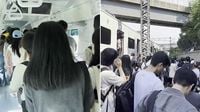On the afternoon of June 12, 2025, a significant disruption unfolded on Seoul’s Metropolitan Subway Line 1, one of the city’s busiest transit arteries. Near Seoksu Station in Anyang, an uptrain experienced a sudden power supply failure, causing the train to halt abruptly and setting off a chain of events that affected hundreds of passengers and disrupted the subway system for hours.
The incident occurred around 3:05 PM when sparks and smoke were reported from the rear of the train as it passed close to Seoksu Station. According to the Gyeonggi Province Fire and Disaster Headquarters, emergency responders received a 119 call alerting them to the electrical malfunction. The train, running on the second of two uptrain tracks between Anyang and Guro stations, immediately stopped, prompting an evacuation.
Approximately 471 passengers aboard the train were safely evacuated after the power failure, with many walking along an access path to the nearby Gwanak Station. Fire officials and Korail, the national railroad operator, coordinated the evacuation to ensure passenger safety. Notably, one 20-year-old woman with diabetes was transported to a temporary medical facility during the process, though no fatalities or severe injuries were reported.
Korail officials confirmed that the incident stemmed from a malfunction in the train’s power supply system, with initial investigations pointing to an electrical problem within the train’s cooling system. The operator dispatched an emergency response team immediately to the scene to assess the damage and begin restoration work on the affected tracks.
The power failure had a ripple effect across the subway line. The Seoul-bound uptrain line operates with two tracks in this section, but due to the incident, one track—the second uptrain line—was blocked for recovery and repair operations. As a result, boarding was suspended at Gasan Digital Complex and Doksan stations, causing delays and forcing Korail to reroute subsequent trains.
Passengers traveling on the affected segment were advised to transfer at Guro Station to downline trains heading in the opposite direction. Meanwhile, the downline trains themselves—those running toward Suwon—continued to operate normally, providing some relief to the disrupted service.
Throughout the afternoon, announcements were broadcast at several Line 1 stations urging commuters to seek alternative transportation options if possible. The disruption lasted for nearly an hour, with the downline trains resuming full service around 3:54 PM and the Seoul-bound trains restarting operations on a single track shortly thereafter.
The incident drew attention not only for the scale of the evacuation but also because it highlighted vulnerabilities in the subway’s electrical infrastructure. Korail has pledged a thorough investigation to determine the exact cause of the power supply failure and to prevent similar incidents in the future.
A Korail spokesperson stated, "An initial response team was urgently dispatched to the site to investigate the cause. We are currently guiding passengers at Doksan and Gasan Digital Complex stations to transfer to downline trains at Guro Station to minimize inconvenience." This prompt response was aimed at restoring normal operations as quickly and safely as possible.
While no injuries resulted directly from the malfunction, the event underscored the challenges of maintaining a vast and aging transit network in a city as populous as Seoul. The swift evacuation and coordinated emergency response were praised by officials, but questions remain about the reliability of the power systems that keep millions of daily commuters moving.
The incident also raised concerns about passenger safety during technical failures. The evacuation of nearly 500 people on foot to a neighboring station was a major logistical effort, and the presence of vulnerable individuals, such as the young woman with diabetes, emphasized the need for robust emergency protocols.
In the aftermath, Korail has committed to a detailed review of the electrical and cooling systems on its trains, aiming to identify any weak points that could cause future breakdowns. The operator’s transparency and communication throughout the incident helped manage public anxiety, but the disruption served as a reminder of the critical importance of infrastructure maintenance in urban transit systems.
As Seoul continues to expand and modernize its subway network, incidents like the June 12 power failure near Seoksu Station provide valuable lessons for balancing efficiency, safety, and reliability. Commuters, transit authorities, and city planners alike will be watching closely as Korail works to restore full confidence in one of the city’s most vital transportation lifelines.

![[속보] 지하철 1호선 석수역 인근에서 열차 운행 정지](https://thumbor.evrimagaci.org/_poVF5WnYGUbZgNMt-_GPAkPiyA=/200x0/tpg%2Fsources%2Fe8cfec7c-ddaa-4bec-96e1-7b9e73c8a116.jpeg)
